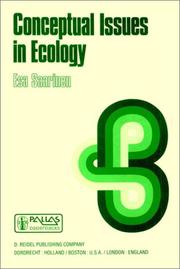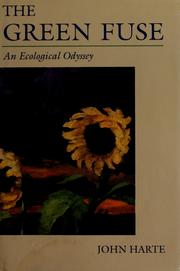| Listing 1 - 10 of 2596 | << page >> |
Sort by
|
Periodical
ISSN: 14401657 Year: 1976 Publisher: [Oxford : Published for the Ecological Society of Australia by Blackwell Scientific Publications,
Abstract | Keywords | Export | Availability | Bookmark
 Loading...
Loading...Choose an application
- Reference Manager
- EndNote
- RefWorks (Direct export to RefWorks)
Ecology --- Balance of nature --- Biology --- Bionomics --- Ecological processes --- Ecological science --- Ecological sciences --- Environment --- Environmental biology --- Oecology --- Environmental sciences --- Population biology
Book
ISBN: 9789264078857 Year: 2004 Publisher: Paris : OECD Publishing,
Abstract | Keywords | Export | Availability | Bookmark
 Loading...
Loading...Choose an application
- Reference Manager
- EndNote
- RefWorks (Direct export to RefWorks)
This detailed background review paper provides a summary of the relevant literature (up to September 2001) relevant to the standardisation and validation of the rodent uterotrophic bioassay. The rodent uterotrophic bioassay is being validated as part of the OECD Test Guidelines Programme. The rodent uterotrophic bioassay is based on the principle that the uterus is under the control of oestrogens to stimulate and maintain growth. If endogenous sources of this hormone are not available, the animal will require an exogenous source to initiate and/or restore uterine growth.
Environment --- Balance of nature --- Biology --- Bionomics --- Ecological processes --- Ecological science --- Ecological sciences --- Environmental biology --- Oecology --- Environmental sciences --- Population biology --- Ecology
Book
ISBN: 9789264076242 Year: 2009 Publisher: Paris : OECD Publishing,
Abstract | Keywords | Export | Availability | Bookmark
 Loading...
Loading...Choose an application
- Reference Manager
- EndNote
- RefWorks (Direct export to RefWorks)
This Test Guideline describes an amphibian metamorphosis assay intended to screen substances which may interfere with the normal functioning of the hypothalamo-pituitary-thyroid axis. The assay was validated with the species Xenopus laevis, which is recommended for use in the Guideline. The assay uses three test chemical concentrations and the necessary controls, including a carrier control if necessary. The assay starts with tadpoles at the development stage 51 on the Nieuwkoop and Faber scale and is extended for a duration of 21 days. Four replicate test vessels are used for each treatment level and control(s). After 7 days of exposure, a sub-set of tadpoles from each treatment level is sampled for the measurement of the length of the hind-limb. At termination of 21-day exposure period, developmental stage, snout-to-vent length and hind limb length are measured on all remaining tadpoles. A sub-set of tadpoles from each treatment level is fixed (whole-body or dissected) for histopathology of the thyroid gland.
Environment --- Balance of nature --- Biology --- Bionomics --- Ecological processes --- Ecological science --- Ecological sciences --- Environmental biology --- Oecology --- Environmental sciences --- Population biology --- Ecology
Book
ISBN: 9789264070202 Year: 2000 Publisher: Paris : OECD Publishing,
Abstract | Keywords | Export | Availability | Bookmark
 Loading...
Loading...Choose an application
- Reference Manager
- EndNote
- RefWorks (Direct export to RefWorks)
This Test Guideline is designed to assess the effects of prolonged exposure to chemicals on the growth of juvenile fish. Juvenile fish in exponential growth phase are placed, after being weighed, in test chambers and are normally exposed to five sublethal concentrations of the test substance dissolved in water preferably under flowthrough, or, if not possible, under appropriate semi static (static-renewal) conditions. The test duration is 28 days. The daily food ration is based on initial fish weights and may be recalculated after 14 days. The study report should include the concentration measurement of the test substance, the observation of external abnormalities and abnormal behavior and the fish weighting at the end of the test. Effects on growth rates are analyzed using a regression model in order to estimate the concentration that would cause a x % variation in growth rate, i.e. ECx. Alternatively, the data may be compared with control values in order to determine the lowest observed effect concentration (LOEC) and the no observed effect concentration (NOEC).
Ecology --- Balance of nature --- Biology --- Bionomics --- Ecological processes --- Ecological science --- Ecological sciences --- Environment --- Environmental biology --- Oecology --- Environmental sciences --- Population biology
Book
ISBN: 9789264221352 Year: 2012 Publisher: Paris : OECD Publishing,
Abstract | Keywords | Export | Availability | Bookmark
 Loading...
Loading...Choose an application
- Reference Manager
- EndNote
- RefWorks (Direct export to RefWorks)
This document describes some endocrine pathways that have been shown to be susceptible to environmental endocrine disruption and whose disruption could contribute to increasing incidents of some disorders in humans and wildlife populations, such as obesity/diabetes/metabolic syndrome, reproductive dysfunction, and neuro-developmental abnormalities. Assays and endpoints are described that could be used in new or existing OECD Test Guidelines for evaluating chemicals for endocrine-disrupting activity. Endocrine pathways evaluated are the hypothalamus:pituitary:adrenocortical (HPA) axis, the hypothalamus:pituitary:gonad (HPG) axis, the somatotropic axis, the retinoid signaling pathway, the hypothalamus:pituitary:thyroid (HPT) axis, the vitamin D signaling pathway, and the peroxisome proliferator-activated receptor (PPAR) signaling pathway.
Environment --- Balance of nature --- Biology --- Bionomics --- Ecological processes --- Ecological science --- Ecological sciences --- Environmental biology --- Oecology --- Environmental sciences --- Population biology --- Ecology

ISBN: 902771391X 9400977964 Year: 1982 Publisher: Dordrecht
Abstract | Keywords | Export | Availability | Bookmark
 Loading...
Loading...Choose an application
- Reference Manager
- EndNote
- RefWorks (Direct export to RefWorks)
General ecology and biosociology --- Ecology --- -Balance of nature --- Biology --- Bionomics --- Ecological processes --- Ecological science --- Ecological sciences --- Environment --- Environmental biology --- Oecology --- Environmental sciences --- Population biology --- Philosophy --- Philosophy. --- -Philosophy --- Ecophilosophy
Book
ISBN: 0030862183 9780030862182 Year: 1973 Publisher: New York Holt, Rinehart and Winston
Abstract | Keywords | Export | Availability | Bookmark
 Loading...
Loading...Choose an application
- Reference Manager
- EndNote
- RefWorks (Direct export to RefWorks)
General ecology and biosociology --- Ecology --- Ecology. --- Balance of nature --- Biology --- Bionomics --- Ecological processes --- Ecological science --- Ecological sciences --- Environment --- Environmental biology --- Oecology --- Environmental sciences --- Population biology
Book
ISBN: 3540066950 0387066950 3642867634 Year: 1974 Publisher: Berlin Springer
Abstract | Keywords | Export | Availability | Bookmark
 Loading...
Loading...Choose an application
- Reference Manager
- EndNote
- RefWorks (Direct export to RefWorks)
General ecology and biosociology --- Ecology --- Tropical climate --- Tropical climate. --- Balance of nature --- Biology --- Bionomics --- Ecological processes --- Ecological science --- Ecological sciences --- Environment --- Environmental biology --- Oecology --- Environmental sciences --- Population biology
Book
ISBN: 0683072781 9780683072785 Year: 1977 Publisher: Baltimore Williams and Wilkins
Abstract | Keywords | Export | Availability | Bookmark
 Loading...
Loading...Choose an application
- Reference Manager
- EndNote
- RefWorks (Direct export to RefWorks)
General ecology and biosociology --- Ecology --- Balance of nature --- Biology --- Bionomics --- Ecological processes --- Ecological science --- Ecological sciences --- Environment --- Environmental biology --- Oecology --- Environmental sciences --- Population biology

ISBN: 0520082079 0520205510 0585276358 Year: 1993 Publisher: Berkeley : University of California Press,
Abstract | Keywords | Export | Availability | Bookmark
 Loading...
Loading...Choose an application
- Reference Manager
- EndNote
- RefWorks (Direct export to RefWorks)
""The force that through the green fuse drives the flower / Drives my green age; that blasts the roots of trees / Is my destroyer," wrote poet Dylan Thomas. In this evocative book a widely respected ecological scientist and activist draws on the poet's image and his own environmental research to demonstrate the intricate interconnections among disparate ecosystems. He takes us from the salmon runs of southwestern Alaska and the marshes of the Florida everglades to the coral reefs of the South Pacific and the depopulated bleakness of the Tibetan plateau. The result is that rare book that bridges the cultures of science and art. Lyrical and vivid portraits of natural wonders and the threats to them are combined with precise scientific accounts of natural processes and their disturbances. The Green Fuse will show nonscientists the fascination of ecological detective work and renew scientists' love for the beauty of the world under their microscopes." "Written from personal passion as well as intellectual analysis, Harte's stories illuminate, without sermonizing, the damage to natural systems brought about by technological hubris and calculated political ruthlessness. To fuse is to join together; "the green fuse" symbolizes the basic unity behind natural diversity. But Harte observes that a green fuse may also be the weak link in an overloaded system or the slow burning wick on an ecological bomb. The scientist's words echo the poet's insight: as The Green Fuse reminds us, the energies that created human liberation from nature can also be those that bring about the human destruction of nature."--Jacket.
Ecology. --- Ecology --- Earth & Environmental Sciences --- Balance of nature --- Biology--Ecology --- Bionomics --- Ecological processes --- Ecological science --- Ecological sciences --- Ecologie --- Environment --- Environmental biology --- Environnement --- Oecology --- Biology --- Environmental sciences --- Population biology
| Listing 1 - 10 of 2596 | << page >> |
Sort by
|

 Search
Search Feedback
Feedback About UniCat
About UniCat  Help
Help News
News